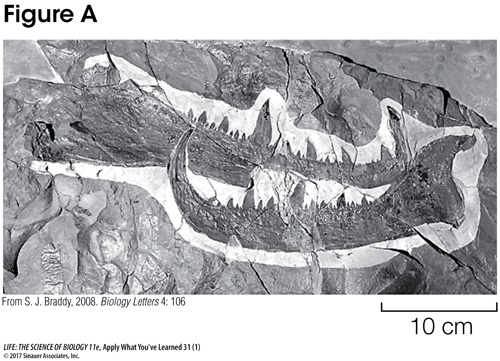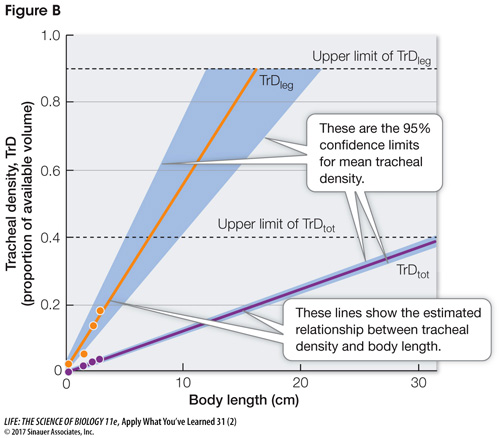Apply What You’ve Learned
Review
31.4
Insects exchange gases via their tracheae.
Original Papers: Braddy, S. J., M. Poschmann and O. E. Tetlie. 2008. Giant claw reveals the largest ever arthropod. Biology Letters 4: 106−109.
Kaiser A., C. J. Klok, J. J. Socha, W-
British scientists recently came upon something striking: a well-

To find out, we must look back to life in the Paleozoic era, approximately 542–
Alexander Kaiser and his team wanted to know why oxygen might increase or limit growth. They knew that the larger an animal grows, the greater the distance required for oxygen to be transported to internal tissue. He thought that perhaps after a certain point the network of tracheae that supplies oxygen would start crowding other organs. To address this, the researchers compared mean values of tracheal density of the leg (TrDleg) and the body (TrDtot) against body length of living beetles from the literature, as shown in Figure B. They then extrapolated upper limits (dashed horizontal lines) of tracheal density in beetles based on the probable density at which tracheae would start to crowd other tissues.

Questions
1.
Describe what is shown in the graph. Which is more limiting to the size of insects, the tracheal density of the leg or the tracheal density of the entire body? Explain your answer.
The graph shows tracheal density of the insects’ legs (red line) and total body (black line) plotted against body length. Researchers wanted to understand the upper limits of tracheal density as a possible limitation for insect size. The tracheal density of the leg is more limiting because it reaches the upper limit threshold at a smaller body size.
2.
How do insects take in oxygen, and how does this compare with how humans and other vertebrates take in oxygen?
Insects take in oxygen through pores called spiracles, which open through the exoskeleton to the outside of the body. Oxygen exchange occurs in the tracheal network, an extensive system of tubes that branch into every part of the body. All living cells in the animal are within micrometers of the tracheal network. In contrast, humans and other vertebrates transport oxygen and carbon dioxide in blood and through a network of arteries, veins, and capillaries.
3.
Based on the graph generated by Kaiser and his team, what size would you predict the largest living beetle could be today, given our current atmospheric oxygen levels? The largest living beetle is Titanus giganteus, which has a body length of approximately 17 cm. Does this fit your prediction?
Based on the graph, one would predict that the largest living beetle could reach a body length of about 15 cm (with 95% confidence limits of about 12–22 cm). This is the approximate length at which the upper limit of tracheal leg density is reached. The largest living beetle (T. giganteus) is slightly bigger than the regression line would predict, but it is within the confidence limits of the prediction.